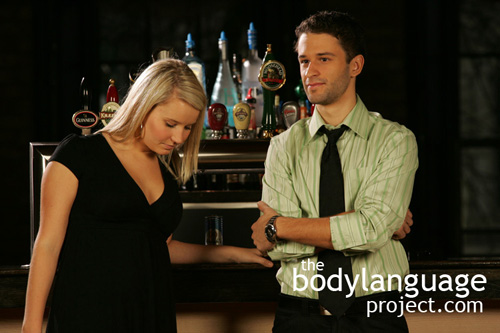Touch reduction is usually accompanied with stressful questions or when information is presented that creates anxiety. Closeness can also be useful when assessing someone because it will invoke distancing desires. When talking with a spouse or child, sit as close as that which you are accustomed to before taking up serious matters. If someone is hiding something, they will usually push away or even stand up looking for ways to exit or change the subject. Holding the hand of a child can be particularly useful when discussing matters of dishonesty. If they wish to exit the discussion, they will try to tug their hand away.
Tag Archive for Everyday Life
Gravity Defying Body Language
by Chris Site Author • March 6, 2013 • 0 Comments
A convenient and accurate way to read someone’s level of happiness is to look for what is called “gravity defying” body language. This is any gestures that makes it seem as if a person is floating on air. We can also call these gestures of exuberance where energy is seemingly in no short supply, being expended just for its own sake. Children will walk excitedly by bouncing up and down on their way to see grandparents or to the town fair, and will sometimes even grab our hands so as to be swung to catch even more air. When we see people with a “Bounce in their step” what we really are seeing is happiness through body language as a person walks on the balls of their feet or when their arms swing confidently at their sides.
When hockey players score a goal, they will immediately throw their hands into the air. The stick is usually thrust upward in concert to defy gravity even more. Alexander Ovetchikin attained part of his fame for his elaborate celebration displays by tossing himself against the hockey rink glass. Bobby Orr’s superman dive after scoring the goal to win the Stanley cup in 1970 is one of the most recognizable images in hockey history. He personified gravity defying body language. Fist pumping is another common, yet much more subdued way to show happiness when we’ve succeeded at something and football has no shortage of exuberant dance moves after scoring a touch-down.
Another gesture that is more commonplace in everyday life happens by when either a toe is raised pointing upward while in a standing position with the weight on the back foot, or the while seated where the toe is facing down, but the heel is upward. Both gestures are gravity defying and signal that good things are happening. While standing, a person might rock back and forth on the balls of the feet or seem to stand taller, more confident and more animated. When people are happy their arms are used more to gesticulate during speech. Gravity defying gestures are rarely faked since they mostly go under the radar and someone in a bad mood usually wouldn’t think of, or be able to hold the gestures for any length of time. Interestingly, those with clinical depression are rarely seen doing these sorts of gestures, instead their shoulders seem to slump and their arms do no more than hang at their sides. Those that are insecure seem to let the weight of life keep them down and pin their arms to their sides.
A Caution About Biases During The Baselining Process
by Chris Site Author • March 5, 2013 • 0 Comments
We also have inherent biases which we must be careful of when try to read other people. Our dislike of certain people could influence us to read their language in a less then favourable light. Knowing that this bias is an inherent possibility, can at least protect us in terms of accuracy, and set up conditions that avoid possibly destructive fallout. This is only one factor to be careful of while reading people as it relates to baselining. Reading lying body language, by example, is very difficult and not having anything to compare it to essentially makes it impossible.
Poker is an excellent game that hones our nonverbal analysis of people, and the best modern day poker players will, with the advent and popularity of televised poker, review thousands of hours of video on their opponents. While some of the time they are watching to pick up on specific “tells” they are also developing their baseline. By doing so, even prior to meeting them they can have some players pegged. They can then use their baseline to determine actions, especially novel ones, that are out of the ordinary. If you’ve ever walked into a new poker group, you understand exactly what I mean. You might know some of the people, but usually there are others that you haven’t yet met add to this a novel context and you’ve got your work cut out for you. Since you don’t know the other player’s baselines you naturally end up being cautious and if you know poker cautious being “tight” can be just as bad as being “loose”. Over time you build their character and they start to “make sense”. In everyday life we call this process “getting to know someone” but in the body language world, we are formulating their baseline. Baselining is really about having the ability to compare someone to themselves.

The ‘nose crinkle’ can mean a negative thought as in getting a bad card in a game of poker. I’ve, however, seen this gesture feigned (and yes I lost the hand over this well executed bluff).
Let’s look at arm crossing or even touching the nose. Everyone thinks that arm crossing means that someone is closed and unreceptive. This might be true for some people some of the time, but to others, it means that they are comfortable. If I were to cross my arms, just now, would it mean I was closed? No, it wouldn’t, it simply means that my arms are crossed. The same goes for nose touching as an indication of lying or deception. Some people touch their nose at the end of every sentence – it’s their idiosyncrasy. Does this mean that every word that comes from their mouth is a lie? It could be, but it is not likely. Once we’ve caught someone in a lie we can backtrack and look at the clues that preceded the lie and those that followed the lie to pick up on cues that might have given him away. Poker players do just this, although for them it’s simpler since there really are only two possible scenarios, he is bluffing, or he really has a strong hand. Video even provides professional poker players with one hundred percent of the information at hand, there are no secrets and so baselining can happen very quickly. In real life, things are not as obvious and there is a lot of gray in between the truth and a lie so it takes a lot more effort do develop baselines, however with practice even novel situations with unknown people will begin to appear similar to other past experiences and people. So baselining provides us with information that we can use in the future when lying or any other emotional behaviour is suspected, where we can draw from our database of “tells” and make educated guesses about the truthfulness, or emotional state of our subject or subjects.


